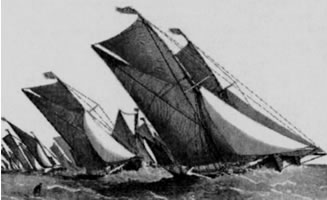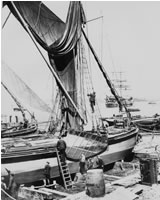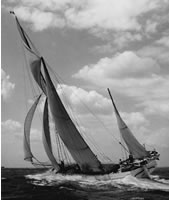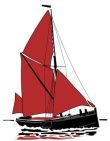
A contemporary etching of the second Thames Sailing Barge Match in 1864.
Henry Dodd’s vision for the Match has endured for 150 years.
Henry Dodd was born in 1801 and started as a ploughboy in the fields within sight of St. Pauls Cathedral. His was a ‘rags to riches’ story and it could be said that his riches came from rags. By his early thirties he had left the land and worked as a ‘scavenger’ sorting rubbish or ‘rough stuff’ as it was known. He discovered that he could make more money moving it, rather than sorting it, so from horse-drawn carts his venture expanded into Spritsail Sailing Barges to deliver the refuse to works on the shores of the Thames Estuary where it was burned and the ash used in brick-making. Before long he added a number of brickworks to his business portfolio. Having initially purchased second-hand barges, he was soon commissioning new craft for his ever expanding empire and by this time he was known around London as the Golden Dustman.

Henry Dodd
Henry Dodd’s burgeoning wealth earned him acceptability in London society, and through his patronage of the theatre, an enthusiasm he shared with Charles Dickens, the two became good friends. It is assumed that Dodd was the inspiration for Mr. Boffin, the wealthy London dustman of Charles Dickens’ novel, Our Mutual Friend.
Dodd discovered that there was much rivalry between his Sailing Barge skippers. He saw this as an opportunity to improve their performance to the benefit of his business and so in 1863 he organised a barge race from Erith to Canvey Island and back, with a cash purse to the winner, under the flag of the Prince of Wales Yacht Club. Whilst it sounds as if the contest was already enjoying royal patronage, the reality was that the Prince of Wales Yacht Club assumed its name from the pub in Erith where the members met!

Shipwrights and crew members prepare the F T Everard
& Sons’ barges for the annual Match at their Greenhithe
yard.
For the following year Dodd opened the entry to allcomers and within a few years passed the Thames Sailing Barge Match organisation to a committee of barge owners. Within ten years Spritsail Sailing Barges were being specially built to win the race and the passenger steamers of the day followed the Match with over 10,000 spectators aboard. When Henry Dodd died in 1881 he left funds from his considerable estate (£100,000) to sustain the Match which endured for 100 years under this bequest. In the latter years of the 19th century, Charles Dicken’s son, also Charles, chronicled ensuing Matches in his annual gazetteer.
For the Centenary Match raced in 1963, the two principal rivals in Britain’s coasting trade, F T Everard and The London & The Rochester Trading Co., lavished money on their fastest barges in an attempt to ensure success for craft which were, by that time, an anachronism in transportation terms. The 48 mile course was from Mucking to the Mouse Lightship and back up to Gravesend. F T Everard’s Veronica was the winner, leaving the rest far behind in her wake.

Veronica’s speed in the 1963 Match would have been sufficient
to win all but six of the America’s Cup contests!
The 150th Anniversary Match on Saturday 13th July 2013, has the contest finishing at Erith for the first time since 1894. Not only is this spectacle thought to be the second oldest sailing contest in the world after the America’s Cup, unlike the America’s Cup of 1851, it is still sailed in craft virtually unchanged since those times, and as such is in itself an especially important part of this nation’s maritime heritage.
